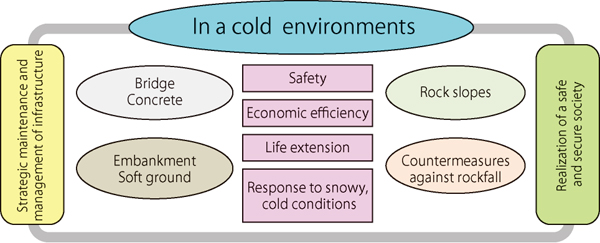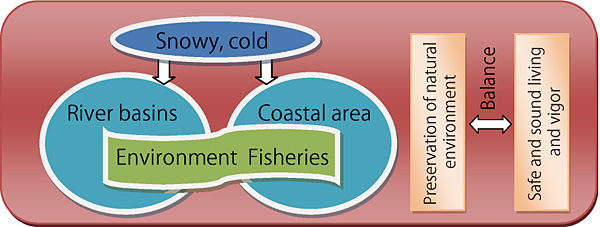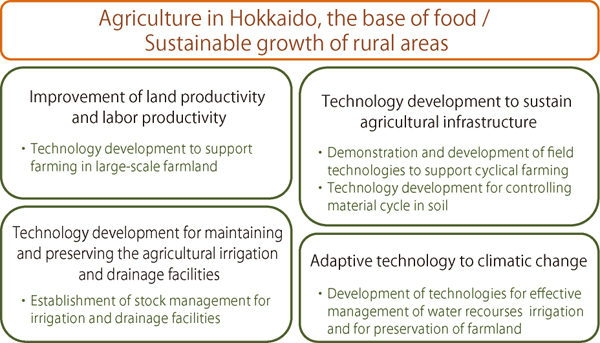This organization of the Director for Cold-Region Technology Development Coordination and his staff was established in fiscal 2008 to promote greater effectiveness and efficiency in resolving technical issues and disseminating research results associated with the development of cold and snowy regions including Hokkaido. The director has established the Cold-Region Technology Promotion Division with the Branch offices and the Machinery Technology Research Team. Each team works cross-functionally across the entire institute and in collaboration / cooperation with respective research teams at the institute and other project institutions. The Cold-Region Technology Promotion Division disseminates research results inside and outside of Hokkaido, and manages intellectual properties. Branch offices are involved in technical dissemination activities and research activities, and the Machinery Technology Research Team is committed to research and development by fully utilizing mechanical technologies in the cold snowy regions and information and communications technologies.

In cold and snowy regions, the construction of infrastructure exposed to severe environmental conditions requires structures and construction methods designed to resist these conditions such as low temperatures. The construction of road embankments and river levees requires measures to stabilize soft ground, because extremely peculiar soil called "peat" is widely distributed on lowlands throughout Hokkaido.
Furthermore, there is the need for measures against rock slope failures that consider the geological and environmental features of coastal and mountainous roads. The Cold-Region Construction Engineering Research Group has organized the Structures Research Team, Geotechnical Research Team and Geological Hazards Research Team to respond to these issues and conduct research on technology development to maintain the performance of structures in cold environments and to reduce rock slope disasters.

Civil engineering structures in cold snowy regions are subject to the actions of freezing and thawing caused by low temperatures, and chloride ions from seawater and deicing salt. So they are deteriorated by frost or combined frost and chloride attack.etc., and their functions are reduced by frost heaving or insufficient bearing capacity.
In order to improve durability and to appropriately maintain the functions of civil engineering structures for a longer period of time under such environmental conditions, developments of design and maintenance technologies adapted to the unique conditions of cold snowy regions in particular are required. In the Cold-Region Maintenance Engineering Research Group, in order to resolve these subjects , the Materials Research Team and the Road Maintenance Research Team, are conducting research to develop technologies to preserve structures: quality control and maintenance, repair, renewal, reinforcement and other technologies to improve durability of concrete or pavement structures in cold snowy regions.
Approximately half of the annual precipitation in Hokkaido falls as snow. This means that the snowmelt runoff mechanism greatly affects the river environment. The prefecture's coastal areas abound in marine resources, but they are prone to severe conditions during winter, including frigid weather and drift ice.
The Cold-Region Hydraulic and Aquatic Environment Engineering Research Group develops technologies that are needed to strike a balance among securing a safe and sound living in river basins and coastal regions, maintaining vigorous socio-economic activities in those places, and preserving the rich natural environment. The Group also surveys interactions among these elements of river management. These studies contribute to state-of-the-art projects of the government.

- River Engineering Research Team
- Watershed Environmental Engineering Research Team
- Port and Coast Research Team
- Fisheries Engineering Research Team
On winter roads in cold snowy regions, congestion, accidents, and road closures are caused by snow falling and accumulating on roads, road surface freezing, whiteouts caused by blowing snow, or snow avalanches. In order to support rich and high quality lives of the citizens of Japan and increase the vitality of cold snowy regions in the face of population decline, aging of society, and tight financial conditions, it is vital to maintain and to improve the functions of winter road traffic by using more efficient and more effective winter road management technologies and effective countermeasures to prevent winter traffic accidents. Climate change which has occurred in recent years has increased the severity of snow and ice disasters such as heavy snowfall, blowing snow, or snow avalanches, and it is necessary to apply countermeasure technologies to deal with these phenomena in order to lower the impact of snow and ice disasters on the daily lives of citizens and on their social and economic activities. Therefore, in the Cold-Region Road Engineering Research Group, the Traffic Engineering Research Team and the Snow and Ice Research Team are conducting research to maintain and improve the functions of roads in cold snowy regions and on snow and ice disaster countermeasures.
Hokkaido is a cold, snowy region with widely distributed problem soils such as peat and heavy clay soil. It is innately a severe farming environment, but soils have been improved and agricultural irrigation and drainage infrastructures have been built. Hokkaido is now home to highly productive large-scale farming practiced mostly by full-time farmers and serves as the food supply of Japan.
To further develop strong agriculture in Hokkaido utilizing the rich water and spacious land resources, the group conducts research and technological development into maintaining and managing existing irrigation and drainage infrastructures in a good condition, for reinforcing drainage and irrigation facilities that are suited for climate variations and changes in the water demand, and establishing a system for utilizing local organic resources and natural energy. These activities are undertaken by the Rural Resources Conservation Research Team and Irrigation and Drainage Facilities Research Team.

A research unit is established to address flexible and multidisciplinary research that meets the needs of government and the public. It is involved in effective and efficient research and development without being divided into research groups or teams.
